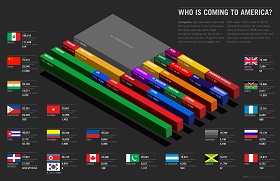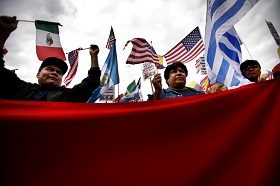Americas's Demographic Challenges
(no votes) |
(0 votes) |
PhD in Politics, Center for Domestic Policy Research at RAS Institute for the U.S. and Canadian Studies, RIAC Expert
With demographic problems becoming increasingly prominent and starting to overwhelm the West, the U.S.A. – the leader of globalization– appears to be suffering their consequences more than other countries. Proclaiming its existence a mighty polyethnic state as the dominant idea for its development, American society is seeing its racial and ethnic structure undergo dramatic changes that are threatening the white majority with a loss of commanding positions in all spheres of societal life. At the same time, whites are known as the nucleus of the American nation. They founded modern American society and have been the driving force behind its civilizational and cultural advancement for over 200 years. What kind of effects will this process have for the country?
With demographic problems becoming increasingly prominent and starting to overwhelm the West, the U.S.A. – the leader of globalization– appears to be suffering their consequences more than other countries. Proclaiming its existence a mighty polyethnic state as the dominant idea for its development, American society is seeing its racial and ethnic structure undergo dramatic changes that are threatening the white majority with a loss of commanding positions in all spheres of societal life. At the same time, whites are known as the nucleus of the American nation. They founded modern American society and have been the driving force behind its civilizational and cultural advancement for over 200 years. What kind of effects will this process have for the country?
Key Demographic Trends are Hampering Development
The latest U.S. census in 2010 started many lively discussions and commentaries, as pundits agreed that American society is going through tectonic demographic shifts of huge political and economic significance, among other things affecting the foreign policy of the global power.
According to the census, in 2010 the U.S. population reached 308.7 million, having risen by 7.3 million or by 9.7 percent since 2000. Although the U.S.A. is still leading the industrialized West with the population growth rate, the first decade of the new century has presented the lowest growth figure during the past 70 years, actually since the Great Depression when the rate was 7.3 percent. U.S. population growth is not coming within miles of the record figures of the 1950s which reached a historic maximum of 18.5 percent (1, 2).
American experts explain the slowdown primarily due to economic factors, such as the two recessions of 2001 and 2008-2009.
The poor trends for most economic parameters combined with the mortgage lending crisis have brought about record low population mobility. In the 2000s, just fewer than 11 percent of Americans changed residence – the lowest figure since World War II, while in the 1950s, the figure was over 20 percent.
Lower geographic mobility will definitely deepen the crisis phenomena in various socio-economic areas, i.e. unemployment, poverty, degradation of urban areas and even entire cities. The trend is vividly demonstrated by bankruptcy of Detroit, the U.S. auto capital that had long symbolized American wellbeing. During its entire history, America had cured its social sores through geographic mobility that eased social tensions in depressed regions like the agricultural South or mining areas in the Appalachians in the East.
The feeling of looming economic troubles and upsets is also underpinned by another factor – the 2010 census was the first in the regular surveys since 1790 to show a drop in average real household income. In 2010, it amounted to USD 50,000, i.e. almost nine percent less than in 2000, when it reached a historic high of USD 55,000. As a result, the absolute number of poor people (individuals with income under the poverty level) in 2010 exceeded 46 million, i.e. more than in 1959 (40 million). Although in relative figures the share of the poor in the total U.S. population slightly exceeds 15 percent, one may say that poverty is becoming a chronic and stagnant phenomenon, multiplying such social stigmas as crime (including use of firearms), drugs, prostitution, HIV/AIDS, illegal businesses and the shadow economy.
Rushing toward a Colored Nation
The most worrisome demographic trend uncovered by the 2010 census lies in changes to the U.S. racial and ethnic composition. Due to immigrant flows gushing into the Promised Land since the end of the Cold War in early 1990s and the effective launch of economic globalization, the number of individuals born outside the United States in 2010 reached 40 million or almost 13 percent of the total population. About 92 percent of the population growth, i.e. about 25 million, are Latinos, Afro-Americans and Asian Americans, whereas the contribution of the whites was a meager 2.3 million. Therefore, in 2010 the share of white Americans fell to 64 percent of the total population, whereas back in 2000 it slightly exceeded 69 percent.
The trend is spectacular in the 100 largest U.S. cities where the whites make up 57 percent versus 71 percent in 1990. Ethnic minorities constitute over a half the population in the 22 largest megalopolises and are increasingly moving to the suburbs, which had become the symbol and the bastion of wellbeing and political influence for the middle class after World War II.
One more long-standing trend accelerating in the past decade has been the uneven distribution of the population's regional growth, with the Southern and Western states adding 23 million and the Northeastern states increasing by only four million.
One specific trend in the West and South is the intensive growth of the colored population since the mid-20th century. In the West, this was due to immigrants from Latin America who rushed in after the adoption of legislation in 1965 that legitimized kinship (and not the employment of skilled foreigners) as the key requirement for obtaining immigrant status. During the previous 50 years, the main inflows had come from the scientifically, technically and economically advanced European countries like Germany, United Kingdom and France, so the U.S. establishment decided that the trend would hold. In addition, immigration reform in 1965 was implemented on the wave of the civil-rights movement that was already in full swing. This is why the reform's general idea was the abolition of discrimination and all restrictions on entry into the U.S. on racial and ethnic grounds.
After 1965, U.S.-bound immigration flows expanded. But instead of giving preferences to skilled West Europeans, the new naturalization system stimulated kinship-based immigration. As a result, immigration flows into the United States acquired a new overwhelming feature. About two-thirds of legal immigrants obtain the appropriate status of close or distant relatives of U.S. citizens, while due to an increase in economic wellbeing in Europe and the gradual strengthening of economic links between the U.S.A. and Mexico, the main immigration streams into the United States have shifted from Europe to Latin America and Asia. Thus, the 1965 immigration reform has drastically altered American immigration priorities, as immigration has acquired predominantly a demographic nature.
The experience of American immigration reform indicates that society is becoming fully aware of their consequences only after three or four decades had passed, which were needed to modify the socio-economic and political factors that condition these transformations. The fourth immigration wave began in the U.S in the mid-1960s and has greatly changed certain demographic parameters of American society. One primary result has been a doubling in the population born outside the U.S.A. over the past 30 years, with newcomers multiplying five times faster than the indigenous populace and Latinos constituting the most numerous group.
Since 1980, Latinos residing in the West have made up 43-44 percent of the total populace. During the past decade, the total population belonging to ethnic minorities in the region kept growing up to 29 percent, while the non-Hispanic whites (1, 2) added just three percent. The South has also been speedily augmented by Latinos, one-third of the population of which mainly settles there (31 percent in 1980 and 33 percent in 2000). From 2000 to 2010, the non-white population in the region grew by 33.6 percent, while the entire white non-Hispanic group increased by only four percent.
However, economically troubled America is dramatically changing its attitude to immigrants and their children born and having grown up in the U.S.A. According to American analysts, "The context for immigration has changed considerably since 2000. Economic times were good at the beginning of the decade, so immigrants, legal and illegal, were drawn by plentiful jobs in an expanding economy. Back then, they were viewed as assets to our labor force and society. Today, amid economic distress, unemployment and shrinking public coffers, immigrants are more likely to be viewed as a drain on resources and as competitors for jobs."
Components of Colored Demography
In 2010, one half of newborn Americans were white, whereas the other half was made up of ethnic minorities. The demographic time bomb mechanism is clearly seen from the 2010 census as white American women had a 10.9 percent birthrate, while other ethnic categories boasted much higher figures, i.e. Latinos – 18.7 percent, Afro-Americans – 15.1 percent, Asians – 14.5 percent, and American Indians and indigenous Alaskans – 11.0 percent. The white women's fertility rate (number of newborns per 1,000 women of reproductive age) was 58.7 percent, whereas Latinos had 80.3 percent, Afro-Americans – 66.6 percent, Asians – 59.2 percent, and American Indians and indigenous Alaskans – 48.6 percent.
Currently the share of white children under five years of age makes up 51 percent, Latin American – 25 percent, Afro-American – 14 percent, and others – four percent of the total. At the same time, for Americans over 85 years old, whites make up 85 percent, Afro-Americans – seven percent, Latin Americans – five percent, and others – two percent.
Since individuals over the age of 85 reflect the racial and ethnic composition of the American society of the 1920s, it seems obvious that over several decades, when the next generation change comes, U.S. society is going to be absolutely different from the popular perceptions of America specific for the final third of the 20th century, which provided the basis for the widespread stereotypes of the exclusiveness of American civilization. Half of the nation's non-white population is entitled to proclaim themselves aboriginal Americans who carry the exclusive American spirit and the unique American system of values in full measure but in their own way.
To this end, according to American demographer William Frey, it appears significant that from 2000 to 2010, U.S. youths under the age of 18 (a total of 74.2 million, i.e. almost two million more than in 2000) underwent a de facto replacement of whites, who went down by 4.3 million, by Latinos, who grew by 4.8 million (other ethnic groups in this category did not change significantly).
Latinos, who make up over one half of the absolute number of the U.S. population (15.2 million), consitute the fastest growing segment of American society in 2000-2010, i.e. from 35.3 to 50.5 million. Hence, the Latino share in the total population has reached 13 percent, making them the second largest ethnic group and pushing the African Americans to the third position. At that, we should note one feature of the rise in the Latino population, which holds great political significance. The main contribution belongs to Mexicans – 11.2 million (75 percent of the increase), followed by Puerto Ricans (1.2 million) and Cubans (slightly over 0.5 million). Immigrants from Central America (apart from Mexico) grew by 2.3 million and from South America – by 1.4 million.
U.S. relations with countries south of Rio Grande, especially with Mexico, have been troubled for centuries, which will definitely affect the perception of their new motherland by different groups of Latin Americans. According to surveys from 2011-2012, about 28 percent of Latinos regard immigration reform as a key priority in addition to the state of the economy, employment, education and healthcare. Among Mexicans, the percentage reached almost 30 percent.
Ageing Population Alters State Priorities
Finally, the 2010 census has unveiled one more novel trend in American demography, i.e. an abrupt growth of the share and absolute number of senior citizens (above 45 years of age) due to ageing, a feature common to all industrialized societies. In fact, the census data are as follows. From 2000 to 2010, the population under 44 years of age grew from 184.5 to 187.0 million (by 1.4 percent), whereas the population over 45 increased from 97.0 to 121.8 million (by almost 26 percent), which makes the growth rate of the latter 18 times higher. At that, elderly pensioners (over 65 years of age) grew from 35.0 to 40.3 million.
The abrupt relative and absolute increase of the ageing population segment that remains politically active requires more economic assets to finance both state and private social programs for pensioning, healthcare, housing and food. Actually, the U.S. economy already has a sector providing infrastructural services for the senior-citizen support that exceeds USD 400 billion in 2011.
The growing social bias of the federal budget expenditures (currently, about two-thirds) is affecting the defense programs intended to ensure U.S. military dominance, including ballistic missile defense and extended operations in faraway regions around the world.
In fact, ageing is making America an introverted society increasingly gearing at solving baffling domestic problems rather than outward expanding and establishing a planet-wide Pax Americana.
The Non-White Factor Rising in Politics
Assessing the current state of the American society, William Frey concludes that the U.S.A. is still a country split by race, ethnicity and age, which is most vividly seen during elections when white seniors go in one direction and the non-white youths in the other.
Complete obsession with domestic political and economic problems is becoming the key function of the U.S. two-party system. Due to fast-moving demographic shifts, the Democrats have become the party of ethnic and other minorities, while the Republicans are increasingly expressing the interests of the shrinking state-forming white populace. The trend visibly surfaced at the 2012 presidential elections, when 59 percent of white voters gave their votes to Mitt Romney, whereas 93 percent of Afro-Americans, 71 percent of Latinos and 73 percent of Asian Americans preferred Barack Obama.
Many American observers believe that the GOP is going through a deep ideological and organizational crisis, and in order to win presidential congressional elections in future, "fundamental reforms are required to take the party in a new direction".
As a result of the above shift in the racial and ethnic orientation of the two key political parties, the main issue of their ideological rivalry is now "the rich against the poor". As a matter of fact, American ethnic minorities have traditionally suffered from low incomes, poor education and illusionary opportunities for social mobility. Due to this, the entire 2012 presidential campaign boiled down to competition between Barack Obama as the candidate of the poor and Mitt Romney as the candidate of the rich. Note that Mr. Obama was supported by 63 percent of the electorate with annual income under USD 30,000 and 57 percent of voters with annual income from USD 30,000 to 50,000, whereas Romney was preferred by 54 percent of voters with income above USD 50,000.
Under the African American president, the confrontation of the rich (whites) and the poor (non-white) has aggravated and virtually paralyzed the federal government, since the 112th Congress (2011-2012) happened to be one of the least efficient in the U.S. modern history. Leading American political and government scholars Thomas Mann and Norman Ornstein believe that the burden of responsibility for paralysis of the government lies on the Republican Party that has become a refuge of ideological extremists deep in nostalgia of the previous socio-economic system and rejecting the legitimacy of their political opponents [1]. Under these conditions one can hardly produce a policy to meet the country's primary needs.
As far as foreign affairs are concerned, the key effect of the fast changing demography is the fact that ethnic minorities lack an imperial way of thinking. Mr. Obama came to power in the midst of the financial and economic crisis with a mandate to end the unpopular wars in Iraq and Afghanistan. But on the whole, the African American president's style – in contrast to George Bush Jr. – is far from imperial. Mr. Obama does not appear to be a crusader striving to spread American values by sword and fire. He is more like a merchant attempting to negotiate optimal deals for this country and extract maximum profit through the proposals one cannot refuse. This is exactly the manner that generates the fierce criticism from his Republican opponents, who fear (not without reason) that after the withdrawal from Afghanistan, U.S. foreign policy will give up claims to global dominance and military hegemony.
Fundamental differences between the Republicans and the Democrats in perceiving the U.S. role in world are increasing in number. For example, during the high-profile hearings in the House Committee on Foreign Affairs in the spring of 2012, in order to substantiate the need to replace the Jackson-Vanik amendment with the Magnitsky Act for the accession of Russia to the WTO, the Republicans described the events in Russia as a revival of the evil empire that required a U.S. response in the spirit of the 1980s, i.e. tough pressure on Moscow over the entire spectrum of the bilateral relationship. The Democrats responded by stating the need for tolerance toward the emerging Russian democracy insisting that "It has taken more than two centuries for the United States to achieve an imperfect form of democratic society. Any African American would agree." [2]
While the white majority, at least its elite, has invariably constructed foreign policy doctrines on the foundation of America's racial exclusiveness, its ethnic minorities tend to be aware of their kinship with other regions of the world – Asia, Africa, Latin America – who had traditionally been removed from the scientific and technological progress and did not enjoy high living standards. Consequently, they are inclined to be more sympathetic to peoples and countries that had lagged behind the industrialized West.
Bibliography:
1. Mann Th., Ornstein N. It's Even Worse Than It Looks: How the American Constitutional System Collided With the New Politics of Extremism. N.Y.: Basic Book, 2012, p. XIV.
2. RUSSIA 2012: Increased Repression, Rampant Corruption, Assisting Rogue Regimes. Hearing before the Committee on Foreign Affaires. House of Representatives. One Hundred Twelfth Congress. Second Session. March 21, 2012. Serial No. 112–141. Wash.: U.S.GPO, 2012, p. 6.
(no votes) |
(0 votes) |







